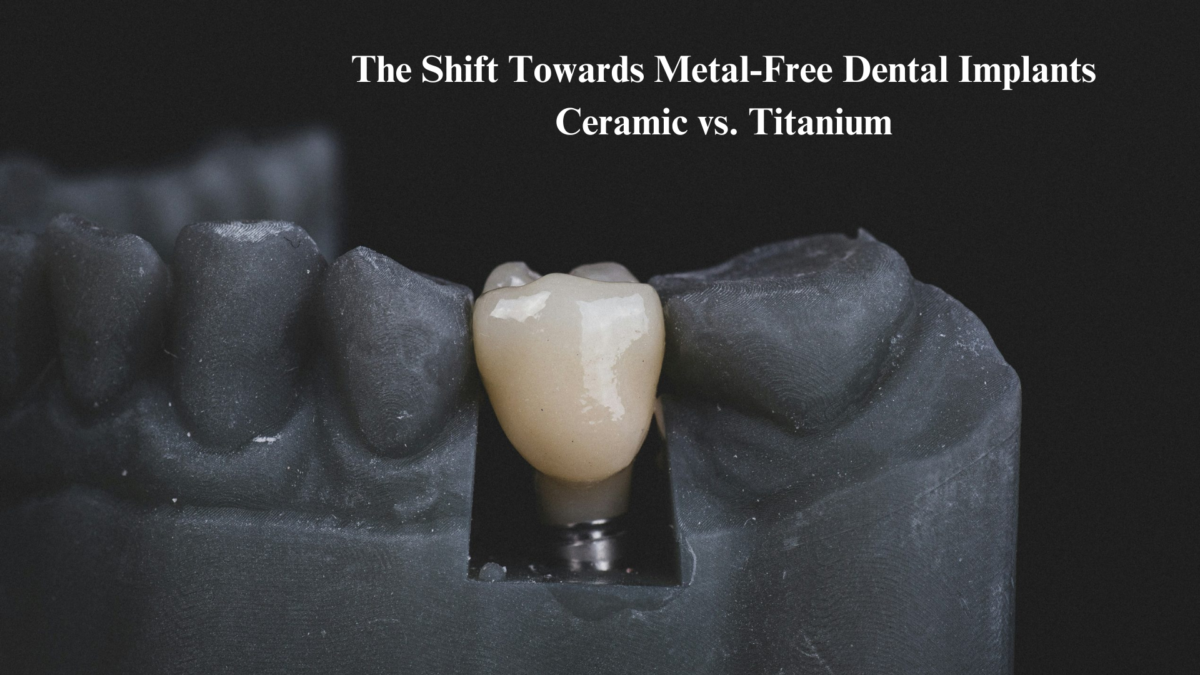
Over the years, dental implantology has experienced significant advancements, with new materials, designs, and procedures revolutionizing the way we approach tooth replacement. One of the most notable trends today is the increasing interest in metal-free dental implants, primarily ceramic implants. For decades, titanium has been the go-to material for dental implants, thanks to its proven biocompatibility and long-term success. However, ceramic implants, particularly those made from zirconia, are gaining traction as a viable alternative for patients seeking a non-metal solution. This shift toward metal-free implants is driven by both aesthetic preferences and potential health considerations, marking a new chapter in dental implantology.
In this article, we will explore the key differences between ceramic and titanium dental implants, the reasons behind the shift toward metal-free solutions, and the factors patients and clinicians should consider when choosing between the two.
Dental implants are artificial tooth roots surgically placed into the jawbone to support a replacement tooth or bridge. They provide a strong foundation for both fixed and removable prosthetics, offering a long-lasting solution for those who have lost teeth due to injury, periodontal disease, or other factors.
A typical dental implant consists of three main components:
Traditionally, titanium has been the material of choice for the implant body, but zirconia ceramic implants have become an increasingly popular alternative.
Titanium dental implants have been the gold standard in dental implantology for over 50 years. The material’s unique properties, such as its high strength, corrosion resistance, and biocompatibility, have made it an excellent choice for osseointegration — the process by which the implant fuses with the surrounding bone. Studies show that titanium implants have a long track record of success, with success rates exceeding 95% in many cases.
Despite their long history of success, titanium implants are not without limitations:
Ceramic implants, particularly those made from zirconium dioxide (zirconia), are becoming a popular alternative to titanium implants. Zirconia is a type of ceramic that offers excellent biocompatibility, strength, and aesthetics, making it an attractive choice for patients who want a metal-free solution.
While ceramic implants offer several advantages, they also come with certain limitations:
The growing interest in metal-free dental implants can be attributed to several factors:
As patients become more focused on the appearance of their smiles, aesthetics play an increasingly important role in treatment decisions. Ceramic implants, with their tooth-colored appearance, offer a more visually appealing option than titanium, particularly in cases where the implant is placed in the front of the mouth or where gum recession is a concern. For patients who prioritize a natural-looking smile, ceramic implants may be the preferred choice.
Although rare, some patients experience allergic reactions to titanium or other metals. In these cases, metal-free ceramic implants provide an ideal alternative. Additionally, patients with autoimmune conditions or those who are particularly health-conscious may prefer to avoid metal altogether due to concerns about potential systemic reactions to metal ions released by titanium implants.
Holistic dentistry, which emphasizes biocompatibility and overall health, is gaining popularity. Many holistic dentists advocate for metal-free treatments to reduce potential interference with the body’s natural energy flow, which is a principle in alternative medical practices such as acupuncture. For patients seeking a more natural approach to dentistry, ceramic implants align with this philosophy.
Sustainability is becoming an increasingly important consideration across all industries, including dental care. While both titanium and zirconia implants have environmental impacts, some patients and practitioners may view ceramic implants as a more environmentally friendly option. This is because the mining and production of metals like titanium can contribute to environmental degradation, while ceramic materials are often perceived as more sustainable.
The choice between ceramic and titanium implants should be made on a case-by-case basis, with consideration for the patient’s specific needs, preferences, and medical history. Key factors to consider include:
If aesthetics are a primary concern, particularly in the smile zone, ceramic implants may be the better option. The white color of ceramic implants ensures that they blend seamlessly with the natural teeth, even in cases of gum recession.
For patients with known metal allergies or sensitivities, ceramic implants offer a safe, metal-free alternative. Additionally, patients with autoimmune conditions or systemic health concerns may prefer ceramic implants to minimize the risk of inflammation or other adverse reactions.
Both ceramic and titanium implants require sufficient bone density for successful osseointegration. However, titanium implants have a longer track record of success in cases of compromised bone quality, such as in patients with osteoporosis or severe bone loss. In these cases, titanium may still be the preferred option due to its proven strength and durability.
Ceramic implants are generally more expensive than titanium implants due to their complex manufacturing process and the novelty of the material. Patients should consider their budget and discuss cost options with their dentist when choosing between the two materials.
While both ceramic and titanium implants are durable, titanium has a longer history of proven success. For patients who prioritize longevity and want a solution with decades of clinical data, titanium implants may still be the preferred option. However, ongoing advancements in ceramic implant technology may close the gap in the future.
The shift toward metal-free dental implants reflects a broader trend in healthcare toward biocompatibility, aesthetics, and holistic treatment approaches. While titanium implants remain the gold standard due to their long history of success and durability, ceramic implants offer an exciting alternative for patients who seek a metal-free, aesthetic solution.
As technology continues to evolve, we can expect ceramic implants to become an even more viable option, particularly as more long-term data becomes available. Ultimately, the choice between ceramic and titanium implants should be based on the patient’s individual needs, preferences, and medical history, with guidance from a qualified dental professional.
For those looking for a modern, aesthetic, and biocompatible solution, ceramic implants may represent the future of dental implantology, offering a promising option for those seeking a metal-free alternative.
#CeramicImplants, #TitaniumImplants, #MetalFreeImplants, #ZirconiaImplants, #AestheticDentalCare, #DentalImplants, #Biocompatibility, #HolisticDentistry, #DentalCare, #Osseointegration